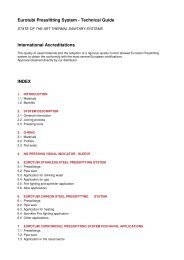Vis PDF - Damstahl
Vis PDF - Damstahl
Vis PDF - Damstahl
You also want an ePaper? Increase the reach of your titles
YUMPU automatically turns print PDFs into web optimized ePapers that Google loves.
Technical<br />
information<br />
Chapter 5: Ferritic, Stainless Steel<br />
Because of the attractive ratio in between corrosion resistance and price, the consumption of ferritic,<br />
stainless steels has almost exploded. In 2006, 27 % of the world-wide consumption of stainless<br />
steel was ferritic alloys, but in 2010, it is estimated that the percentage may reach as high as 47. In<br />
particular the car factories are major consumers of ferritic stainless steel, and as Scandinavia possesses<br />
a comparatively small car industry, the 2006 and 2010 numbers for Scandinavia are “only” 15<br />
and 25 %, respectively. This increase is due to household appliances, catering and so.<br />
Pitting Corrosion<br />
In most media, local corrosion resistance is dependent on the contents of Cr and Mo, and while<br />
the ferrites of the past usually contained around 12 % Cr and no Mo at all, the ferrites of today are<br />
much higher alloyed and the corrosion resistance correspondingly higher. As a result, the ferrites<br />
of today are fully capable of competing with the traditional austenites (both “normal” stainless and<br />
“acid resistant”) as regards corrosion resistance.<br />
With respect to pitting corrosion, one of the most destructive types of corrosion for stainless steel,<br />
the corrosion resistance, is determined by the Pitting Resistance Equivalent, the PREN (Chapter 4).<br />
Empirically, two stainless steel grades with equal PREN numbers posses the same resistance towards<br />
initiation of pitting corrosion, and, using the table above, 4301 (AISI 304) has a PREN of 17.5.<br />
The ferritic 4509 has exactly the same PREN which means that the two types 4301 and 4509 can<br />
be expected to perform equally well towards pitting corrosion. In October-November 2008, this was<br />
confirmed by experiments conducted at the Technical University of Denmark (DTU).<br />
Similarly, the ferritic 4521 (PREN 22.9) can be expected to perform equal to the austenitic 4404<br />
(AISI 316L, PREN 23.1), and, not surprisingly, this was also confirmed by the Technical University of<br />
Denmark (DTU). Actually, the pitting potential of the acid resistant ferrite, 4521, proved to be significantly<br />
higher than that of the parallel austenite, 4404. Consequently, for both groups of steel (4301<br />
/ 4404), it is possible to substitute the traditional austenite with the parallel ferrite and maintain the<br />
resistance towards pitting corrosion.<br />
The above considerations apply for the initiation of pitting corrosion. Should the corrosion, against<br />
all precautions, start, Ni is a beneficial element, and corrosion tends to propagate faster in a Nifree,<br />
ferritic steel than an austenitic steel type. However, this is just an additional argument for<br />
choosing stainless steel with care. Quite simply, one has to choose stainless steel where the corrosion<br />
will never initiate. Just choose steel with a sufficiently high PREN.<br />
Stress Corrosion Cracking<br />
Stress Corrosion Cracking (SCC) is a type of corrosion giving rise to cracks due to a combination of<br />
mechanical stress and exposure to certain corrosive media, and it is normally regarded as the most<br />
destructive type of corrosion. SCC specifically attacks the austenitic steel types, and in particular<br />
the 4301 and 4401/04 groups are vulnerable, particularly in chloride containing media.<br />
As a guideline, SCC is a risk for 4301 at temperatures above only 50-60 ºC while the “acid resistant”<br />
4401 class lasts until 100-110 ºC (Chapter 4). This actually makes the austenitic stainless steel inadequate<br />
for a number of technical appliances ranging from reactors and distillation columns to heat<br />
exchangers, evaporators and drying equipment.<br />
299<br />
www.damstahl.com<br />
01.2013
















